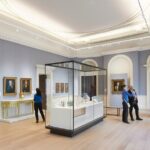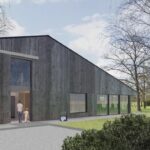John Latham Flat Time House, FTHo London, Sculpture, Peckham Home, Architecture
Flat Time House : FTHo
John Latham Exhibition: Distress of a Dictionary, London, England, UK
Address: 210 Bellenden Rd, London SE15 4BW
Phone: 020 7207 4845
JOHN LATHAM’S FLAT TIME HOUSE OPENS, 2 OCTOBER 2008
Opening Exhibition: Distress of a Dictionary, 2 Oct – 2 Nov 2008
23 Sep 2008
John Latham Flat Time House
The Trustees of the John Latham Foundation today announced the opening of Flat Time House (FTHo), the home of the late artist, to the public on 2 October 2008.
John Latham (1921 – 2006), one of the most important British artists of the post-war period, lived at FTHo in Peckham, Southeast London for over 20 years. The House is now home to the John Latham Foundation and the John Latham Archive, and will be the primary location for a 10-month programme of exhibitions and events exploring the artist’s practice, his theoretical ideas and their continued relevance.
The opening show, Distress of a Dictionary, will be a solo exhibition exploring the role of language and humour in Latham’s work.

They’re learning fast, 1988
Fish tank, pages from ‘Report of a Surveyor’, piranha fish
47 x 91 x 30 cm
Courtesy John Latham Estate and Lisson Gallery
© The Artist
Latham considered the house a ‘living sculpture’, with different rooms taking on the attributes of a living organism. At FTHo, a giant and colourful book-relief sculpture penetrates a large window on the front of the house, known as the Face, into a room called the Mind, in which a permanent installation of works demonstrating Latham’s Time-Base Theory has been maintained. The next room is known as the Brain.
Latham described it as the space for ‘rational thought’ and this is where he worked on his theoretical writing and correspondence. The Brain will now be home to the John Latham Archive. The Hand, formerly Latham’s studio, will be the main location for the programme of changing exhibitions and events.
The remainder of the house is taken up with what is termed the ‘Body Event’, where eating, sleeping and ‘plumbing’ take place. The name of the house derives from John’s theoretical language, in which ‘Flat Time’ describes the way in which time and all possible events can be represented by the length and width of a flat canvas, demonstrated in
works including Time-Base Roller (1972. Tate Collection).
In the painting and sculpture for which he is best known, Latham’s primary materials included glass, books, canvas and the spray gun. Developing alongside this concise visual language, from the mid-1950s onwards, was a cosmological theory, formulated through his art-making discoveries that considered time and event to be more primary than the established means of understanding, based on space and matter.
Termed Time-Base Theory it offers an ordering and unification of all events in the universe including human actions, allowing an understanding of the special status of the artist in society, and is articulated by a permanent installation at FTHo.
The programme at FTHo will explore important moments and themes within Latham’s practice, including his involvement with underground culture in 1960s London, his interest in ecological issues and solutions and a re-evaluation of his work in film and video. Works by Latham’s contemporaries and collaborators will also be exhibited, as well as pieces by a younger generation of artists influenced by his practice. The programme at FTHo will run from October 2008 to July 2009 and is supported by the John Latham Foundation and Lisson Gallery.

John Latham
Classical Painting, 1988
Wooden draw, books, plastic tubes and expanded foam
16 x 12 cm
Courtesy John Latham Estate and Lisson Gallery
© The Artist
Latham has been associated with several national and international artistic movements since he began showing work in the late 1940s. He is associated with the first phase of conceptual art of the 1960s, was an important contributor to the Destruction in Art Symposium of 1966, and was a founder member of the Artist Placement Group (1966-89). Latham’s work has been exhibited internationally, including recent solo exhibitions at Tate Britain (2005) and PS1, New York (2006).
His work has been included in numerous historic group shows and many survey exhibitions of British Art since the 1960s including Live in Your Head (Whitechapel Gallery, London, 2000), From Blast To Freeze (Kunstmuseum Wolfsburg, Germany, 2003) and Art and the 60s: This was tomorrow (Tate Britain, 2004). Latham’s work is held in collections worldwide, including Tate Collection and MoMA.
John Latham’s work has been represented by Lisson Gallery since 1970.
http://www.lissongallery.com/#/artists/john-latham/
VISITOR INFORMATION
Flat Time House, 210 Bellenden Road, London, SE15 4BW
Hours: (during exhibitions): Thu – Sun 11am – 5pm
FTHo will also be open by appointment for private study and research.
Admission: Free
Directions: The nearest train station is Peckham Rye. Regular bus services operate to Peckham Rye or Peckham Square.
Artist Placement Group (APG): An initiative by Barbara Steveni, APG was cofounded with John Latham, Jeffrey Shaw and Barry Flanagan in 1966. The group pioneered new models for the artist working within industry and government departments. Their work continues to provoke debate around the role of the artist in society, as well as socially engaged and relational art practices. The APG archive was acquired by the Tate Collection in 2005.
John Latham Archive/Ligatus Research Project (JLA): JLA is a project of the Ligatus Research Unit at the University of the Arts, London. Central to the project is the cataloguing of the Archive housed at FTHo and the creation of an online database through which documents can be accessed by students and other researchers. The project has been supported by the Henry Moore Foundation and the Arts and Humanities Research Council.
http://www.ligatus.org.uk
John Latham Flat Time House London info from Calum Sutton PR 100708
Location: 210 Bellenden Road, London SE15 4BW, England, UK
London Buildings
Contemporary London Architecture
London Architecture Links – chronological list
London Architecture Tours by e-architect
London Art Galleries
Timothy Taylor Gallery by Eric Parry Architects

photo from Eric Parry Architects
Serpentine Pavilion London
Design: SANAA

photo © Nick Weall
Saatchi Gallery, Chelsea
Design: Allford Hall Monaghan Morris

image © Timothy Soar
Comments / photos for the John Latham Flat Time House London page welcome





